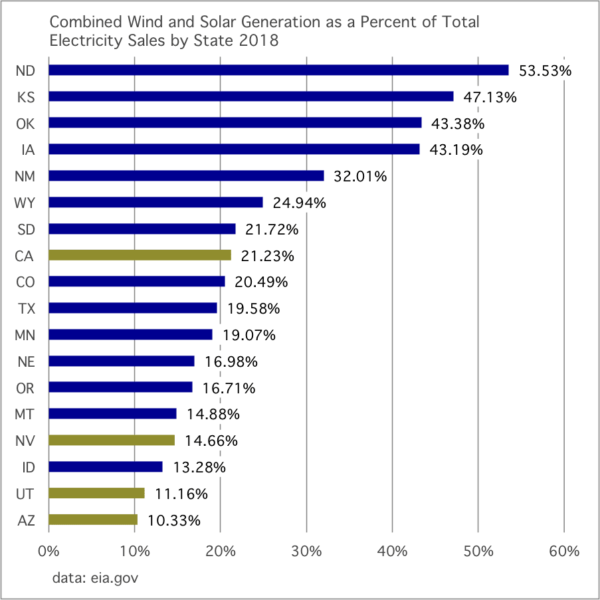If we needed any further evidence that headline target of the Green New Deal – the full decarbonization of electricity – would be accomplished at the state level before the federal level, New Mexico just supplied it.
Yesterday the New Mexico House passed SB 489 (bill text), which mandates that the state move to 100% zero-carbon electricity by 2045, the same language and date as the mandate set in California. The 43-22 vote in the House follows on the Energy Transition Act passing the New Mexico Senate on March 6.
The bill will now go to the desk of New Mexico Governor Michelle Grisham (D), who is expected to sign it, as she campaigned on a pledge to move the state to 80% renewable energy by 2040.
Renewable or zero-carbon?
Like California’s zero-carbon standard, the Energy Transition Act in New Mexico is really two mandates: a mandate for zero-carbon electricity, and a mandate for renewable electricity. And while both have the identical 2045 timeline for zero-carbon electricity, they set slightly different standards for renewables.

Graphic: Gregor Macdonald
California now has a 60% by 2030 renewable portfolio standard, while New Mexico went with a less aggressive 50% by 2030. However SB 489 also sets a mandate that utilities in the state source 80% of their electricity from renewables by 2040, per governor Grisham’s pledge.
And while 50% by 2030 would be ambitious for many states, it is not much of a stretch for New Mexico. In-state wind and solar generation already was equivalent to 32% of the state’s electricity sales in 2018 – the fifth-highest portion nationally – per an analysis by energy writer Gregor MacDonald using U.S. Department of Energy data.
Hydro and nuclear power
New Mexico has limitations on big hydro in the renewable energy portion of the pending mandate under the Energy Transition Act. Similarly, California’s policies do not include large hydro plants in their definition of renewable.
The only other resource that is currently deployed at scale which could qualify as zero-carbon is nuclear power; California only has one nuclear power plant left, which is scheduled to retire in 2025, while New Mexico has none. However utility El Paso Electric, which has service areas in both Texas and New Mexico, has contracts to buy power from a portion of the 4 GW Palo Verde nuclear plant in Arizona, which is the largest nuclear power plant in the United States.
It is also possible that future zero-carbon generation technologies could fill the gaps in each state between the renewable energy mandate and the zero-carbon mandate, and these policies leave the door open for that.
This content is protected by copyright and may not be reused. If you want to cooperate with us and would like to reuse some of our content, please contact: editors@pv-magazine.com.









Please allow me to posit; a 12 months per year and 24/7 100% zero-carbon-electrical-grid is achievable with technology that is on-the-shelf today. Requiring renewables is too much INTERVENTIONISM and will obstruct technological innovation among entrepreneurs from where the “disruptive technology” originates.
If the goal is a zero-carbon-energy-infrastructure; then all forms of zero-carbon-electricity must be allowed and too much dependence upon renewables will slow the process. Let the markets and the entrepreneurs “innovate” and “disrupt” with all forms of zero-carbon-electricity, not just renewables.
Adam Smith would agree with me.
Adam Smith isn’t around, and it is a poor choice to take a historical figure and ascribe your beliefs to him on a specific matter.
We plan for the future based on the technology choices that are available today or likely to be available in the near future. The one non-renewable zero carbon technology that has been commercialized – nuclear power – has not delivered: chiefly on price, but also in terms of other societal outcomes.
And this is another warning regarding ALL CAPS. As I have stated before, it is the internet equivalent of shouting, and we reserve the right to reject comments for use of ALL CAPS.
Bravo! It is encouraging to see New Mexico step out as progressive leader on decarbonization!!!
This article misses that PNM, New Mexico’s largest electric utility, owns a 10% share in Palo Verde. Good to hear that New Mexico is taking this path forward and hope they can go further with renewable power even sooner.
Thanks for that additional detail.